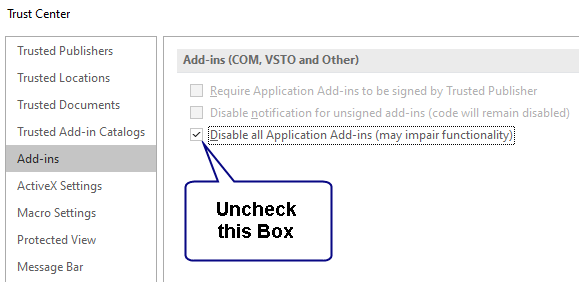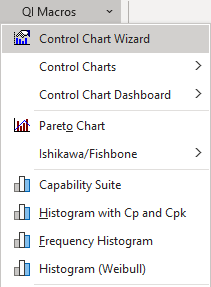QI Macros Technical Support Questions
PC
Channel |
Version | Build |
Release Date |
|---|---|---|
Monthly |
2405 | 17628.20110 |
May 30, 2024 |
Semi-Annual (Targeted) |
2208 | 15601.20870 |
February 13, 2024 |
Semi-Annual |
2202 | 14931.21078 |
August 8, 2023 |
NOTE: Only Desktop Versions of Microsoft 365/Office 365 are compatible with QI Macros - Online versions of 365 do not have the required functionality to run QI Macros successfully.
To check which version you currently have installed, open Excel and select File > Account > About Excel.
And click the following link to veiw Microsoft Office's Release History.
When you install a new version of Excel, QI Macros isn’t automatically linked – you must reinstall QI Macros using your QI Macros install file.
Note: If your QI Macros is more than a year old, it may not be compatible with the latest version of Excel.
If you can't find your Install file and your QI Macros version is less than 5 years old, you may be able to retrieve your license by using one of the following methods:
- If you have your order ID (or invoice number) and password, click here to enter and download your setup file.
- You may also use your e-mail and zip code to find your setup file, click here to enter and download your file.
- If we cannot find your setup file because your e-mail isn't in our database, we can look it up for a fee. E-mail support@qimacros.com or call 888.468.1537.
If you require additional technical support, e-mail support@qimacros.com or call: 1.888.468.1537
If you have downloaded the QI Macros install file, but when opening it, recieve a "qimacros isn't commonly downloaded. Make sure you trust qimacros before you open it" message, this is because of the security settings within your Microsoft Edge web browser.
To troubleshoot this matter:
- Use a different web browser to download the install file (e.g. Mozilla Firefox, Google Chrome, etc.).
- Click on the (3) dotted "More actions" option to the right of the trash can icon and select "Keep".
- Once you have selected "Keep" then select the "Show more" drop-down and select "Keep Anyway".
*OR*
If you require additional technical support, e-mail support@qimacros.com or call: 1.888.468.1537
The QI Macros install files are located in:
C:\ Program Files \ QIMacros \ xlstart
And the contents of the “xlstart" folder should look like this:
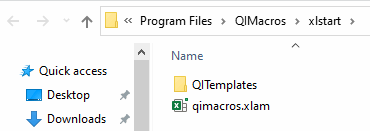
NOTE: If your folder is missing the .xlam file or QITemplates folder, close Excel and reinstall QI Macros.
There may be a conflict with other add-ins. The solution is to find out which one:
- Start Excel in Safe Mode by holding down the CTRL key and starting Excel – this will not load any add-ins.
- Click on File > Options > Add-ins:
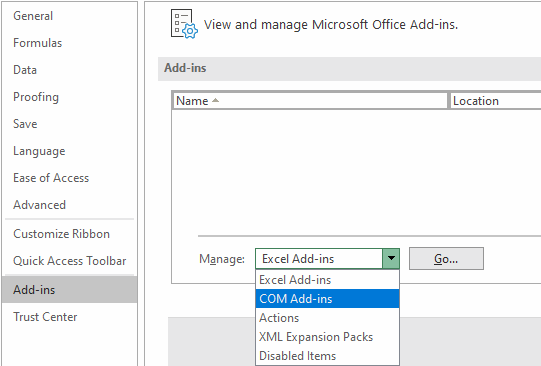
- First click on COM add-ins and uncheck any unused add-ins.
(The Acrobat Add-in seems to be especially problematic, due the preview feature. You can save a PDF directly from Excel.)
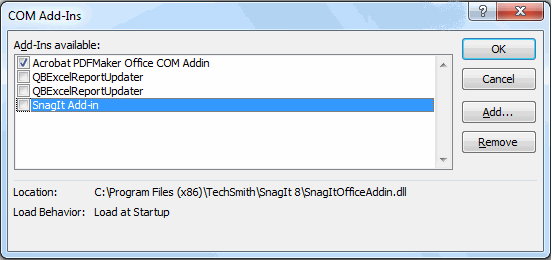
- Then, click on Excel Add-ins and de-select any unused add-ins.
Also, uncheck “Solver Add-in” to speed up loading Excel, unless you need it. Most users do not!
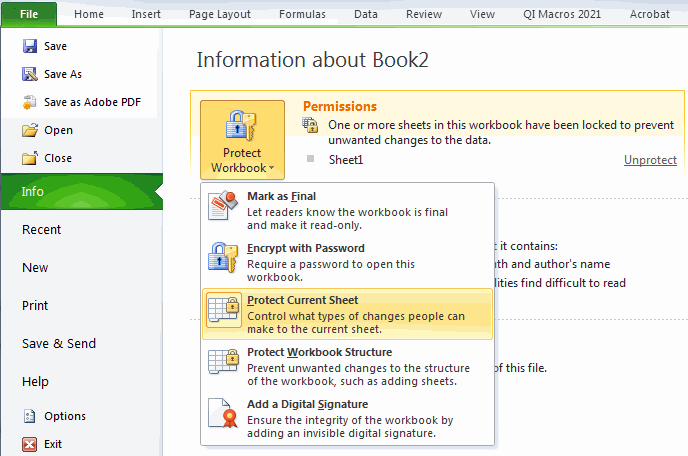
- Completely quit out of Excel and reopen. But this time, open normally – not in Safe Mode, and see if this clears the problem.
If it does not, repeat until you find the conflicting add-in.
If Excel is still crashing during startup, e-mail support@qimacros.com or call: 1.888.468.1537
NOTE: Excel's spreadsheet limitations are 1,048,576 rows by 16,384 columns.
If you created an Excel file using QI Macros, and it is taking longer to save than it should, check to make sure that the Excel file is placed on your local drive. If you are opening it from and saving it to a location that is NOT your device (e.g., A local server), this could be slowing the saving process down considerbaly.
If, however, this is not the case, see potential troubleshooting measures below:
- Check to see how much space you have available on your device – overloaded hard-drives can negatively impact the performance of software packages such as Excel.
- Check for Excel Bloat – this would typically occur in previous versions of Excel, such as 2016 and older. It can make your Excel perform slowly until the bloat has been cleared.
- WINDOWS 10 DEVICES ONLY: Check for paging issues, as Windows 10 has been known to perform slowly if the paging settings are not optimal for the device.
If you are still receiving this message, e-mail support@qimacros.com or call: 1.888.468.1537
* TO TROUBLESHOOT THIS MATTER, YOU MUST FIRST ENLIST YOUR IT DEPARTMENT FOR HELP *
Explanation: Often IT will change security parameters for all users on an entire network.
And if you do not have permission to open a specific Excel file, it will display the error "Excel cannot open the file because the file format or file extension is not valid." If this is the case and you can no longer open macro-enabled files (files ending in .xlam, .xltm or .xlsm), then you will no longer be able to use QI Macros on your device.
To troubleshoot this matter, have your IT department adjust your permissions to allow you to open macro-enabled files. They can do so by adjusting your permissions and by also following these steps:
- Right-click the Excel file that cannot be opened and select Properties:
- After the file’s "Properties" window opens, select the Security tab, and then click the Edit button:
- After the file’s "Permissions" window opens, click the Add button:
- When the "Select Users or Groups" window opens, click the Advanced button:
- And when the next window opens, click Find Now so all users and groups will show up in the search results list at the bottom of the window:
- Select the Everyone group from the list, and then click OK:
- And click OK again:
- When you return to the "Permissions" window, you will see that the Everyone group has been added to the group or user list. Select the Everyone group, check all checkboxes under Allow, and then click Apply and OK:
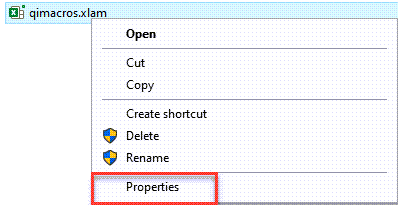



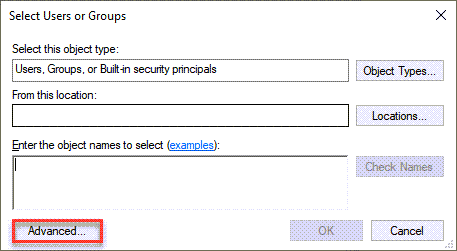
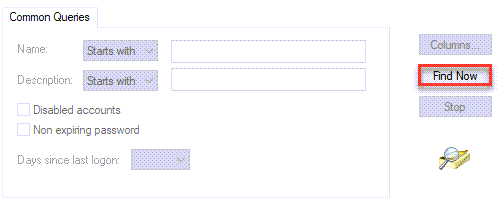
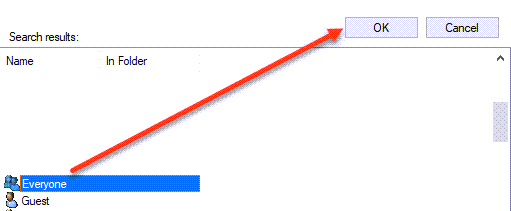
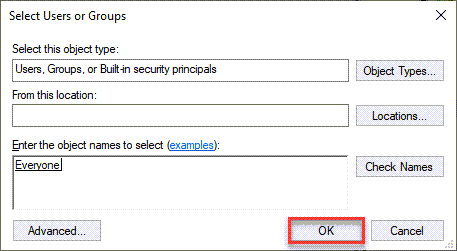
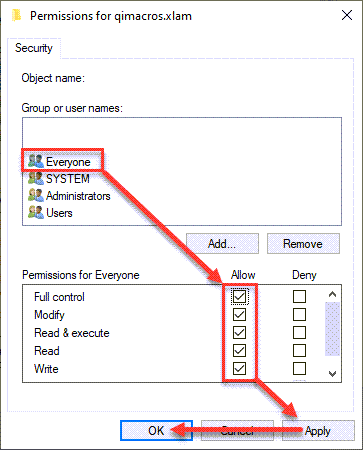
* TO TROUBLESHOOT THIS MATTER, YOU MUST FIRST ENLIST YOUR IT DEPARTMENT FOR HELP *
If you are still receiving this message, your IT Department can add an Exception/Exclusion within your anti-virus software to allow your system to open the QI Macros menu file.
Below are instructions on how to do so in Windows Defender/Microsoft Security:
- Go to “Start” in the bottom left of your device and select Settings > Update & Security > Windows Security > Virus & threat protection.
- Under the “Virus & threat protection” settings, select “Manage settings” and then under “Exclusions,” select “Add or remove exclusions.”
- Next, select “Add an exclusion” and select the pathway C:\Program Files\QIMacros – this will exclude the entire QIMacros folder from being blocked by your anti-virus software.
- And once you have done so, move the qimacros.xlam file and QITemplates folder BACK into the pathway: C:\Program Files\QIMacros\xlstart.
- Open Excel – do you now see the QI Macros menu in your Excel ribbon?
If not, Defender can sometimes keep the protection history, which needs to be manually removed - see additional steps below:
- Close Defender.
- Open your File Explorer and go to the following pathway:
- Once there, delete the contents of the "History" folder - and once deleted, check to see if "qimacros.xlam" has been removed from the History list in Defender.
C:\ProgramData\Microsoft\Windows Defender\Scans\History
NOTE: If "qimacros.xlam" is still listed in Defender, select the option to perform an Offline Scan with Defender - your PC will need to reboot to perform this scan. And once rebooted, "qimacros.xlam" should be removed from Defender.
If you are still receiving this message, check to make sure C:\Program Files\QIMacros\xlstart\ is listed as a Trusted Location in Excel. To do so, see instructions below:
- Open Excel and select File > Options > Trust Center > Trust Center Settings > Trusted Locations:
- If C:\Program Files\QIMacros\xlstart is NOT listed in your Trusted Locations list, select the "Add New Location" button to manually add the pathway as a Trusted Location:
- Once you have done so, completely quit out of Excel and reopen Excel - do you still receive the same message?

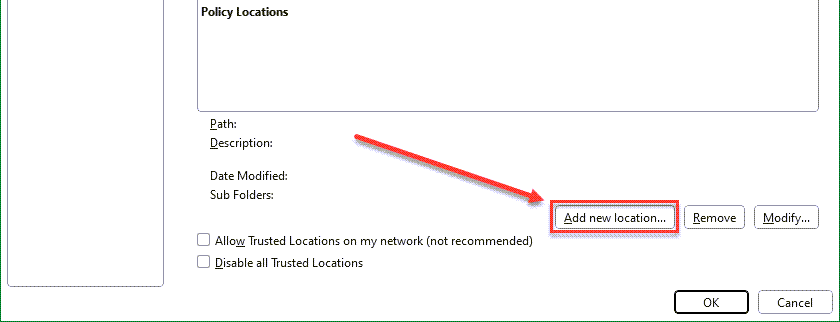
* TO TROUBLESHOOT THIS MATTER, YOU MUST FIRST ENLIST YOUR IT DEPARTMENT FOR HELP *
If you are still receiving this message, follow the additional steps below:
- Completely quit out of Excel.
- Cut the qimacros.xlam file from C:\Program Files\QIMacros\xlstart
- Locate the XLSTART folder attributed to your specific version of Excel (e.g., Office 365/Excel 2021: C:\Program Files\Microsoft Office\root\Office16\XLSTART)
- Paste the qimacros.xlam file into the XLSTART folder.
- Open Excel - do you still receive the same message?
If you are still receiving this message, e-mail support@qimacros.com or call: 1.888.468.1537
If you have selected a point on your control chart and are receiving an "Excel did not recognize the point selected" message when using any of the QIMacros Chart tools (e.g. Show Process Change, Fix Control Limits):
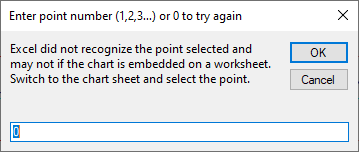
- Select "Cancel" and double-check that you have actually selected the point on your chart, instead of perhaps one of the hidden points on your Sigma Line(s).
- If the actual point on your chart is indeed selected, try using the QIMacros Chart tool again.
- If you receive this message yet again, it is because Excel cannot remember the point you selected - this is a bug within Excel. To troubleshoot, click on another point in your chart and then re-select your original point, before trying to use the QIMacros Chart tool again.
If you are still receiving this message, e-mail support@qimacros.com or call: 1.888.468.1537
A small percentage of Excel users are finding that when they install Microsoft Office, VBA is not included. Unlike Office 2010, you are not able to go into the Control Panel and simply select what features you want to include or disable in your Office Suite – VBA is supposed to be automatically included.
To check, select Alt+F11 while in Excel. If the Visual Basic Editor window does NOT open, VBA is not enabled or installed.
To double-check, open Excel and select File > Options > Customize Ribbon > Developer. If "Developer" is not included in your Main Tabs list, add it from the "All Commands" list. And once added, the Visual Basic and Macros buttons should be clickable.
If they are not clickable, open the Registry Editor, select Ctrl+F and search for VBAOff. If an entry is found, look to see if the Value Data is set to 1. 1 = VBA is disabled, 0 = VBA is enabled. If it is set to 1, change the Value Data to 0, with Excel completely closed. Press OK, open Excel, and select Alt+F11 - does the Visual Basic Editor open? If so, VBA is now enabled! However, if VBA is not included, Microsoft says the workaround is to perform a Quick Repair via the Control Panel (Control Panel > Programs > Programs and Features > Microsoft Office 365 > Change).
If that does not work, completely uninstall Microsoft Office, using these instructions.
This will remove any traces of the previously installed version of Microsoft Office. Once completed, run a “clean install” from your Microsoft Office installer or Office 365 account.
Now that Office has been reinstalled, open Excel – do you still receive the Runtime Error?
If so, e-mail support@qimacros.com or call: 1.888.468.1537
If you are receiving the following message:

It is because Excel automatically quit out of the QI Macros installation when trying to access: C:\Program Files\Microsoft Office\Root\Office16\EXCEL.EXE
To troubleshoot this matter, go to the following pathway: C:\Program Files\QIMacros\xlstart
In the xlstart folder, do you see a qimacros.xlam file, along with a QITemplates folder? If so, download and open the Add-QIMacros.xlsm file in Excel and select "Enable Editing" and/or "Enable Content" when prompted.
Once you have done so, select the "Click Here to Add QI Macros" button, completely quit out of Excel and reopen Excel - you should now see the QI Macros menu in your Excel sub-ribbon!
If you still do not see the QI Macros menu, e-mail support@qimacros.com or call: 1.888.468.1537.
If you are receiving this Runtime-Error '1004' prompt when trying to create a Control Chart, it is because your data set either does not have headers, or you are not selecting the headers in your data set when creating your chart.
To troubleshoot this matter, make sure you select the headers AND your data before creating your Control Chart.
If you still receive this Runtime Error, e-mail support@qimacros.com or call: 1.888.468.1537.
If you are receiving a Runtime Error 52, there are is an issue with your device's ability to access the SysData Directory when calling QI Macros into Excel. See troubleshooting options below:
- Go to C:\Program Files\QIMacros\xlstart and copy and paste the "xlstart" folder directly to your Documents folder.
- Next, copy the Documents\xlstart folder pathway. To do so, open the xlstart folder in your Documents folder, right-click on the breadcrumb, and select "Copy address as text":
- Open Excel and select File > Options > Advanced. Scroll down to the "General" section, and in the "At startup, open all files in:" textbox, replace the pathway C:\Program Files\QIMacros\xlstart with your Documents\xlstart pathway by performing a Paste.
- Press "OK", completely quit out of Excel, reopen Excel and open a blank workbook - do you now see the QI Macros menu in your Excel ribbon, and are you still getting a Runtime Error 52 message?
- If so, this is because the necessary QI Macros install files are located in two separate places on your device. With that, QI Macros does not know which location to open the files from. To troubleshoot this matter:
- Delete the qimacros.xlam file and QITemplates folder from C:\Program Files\QIMacros\xlstart
- Next, reopen Excel – do you still receive the Runtime Error?

If so, e-mail support@qimacros.com or call: 1.888.468.1537.
If you are receiving a Runtime Error 52, this is because the necessary QI Macros install files are located in two separate places on your device. With that, QI Macros does not know which location to open the files from.
To troubleshoot this matter:
- Remove the qimacros.xlam file and QITemplates folder from C:\Program Files\QIMacros\xlstart
- Open Excel, open a blank workbook, and go to File > Options > Advanced. Scroll down to the “General” section and in the “At startup, open all files in” textbox, delete the pathway entry “C:\Program Files\QIMacros\xlstart”.
-or-
Next, reopen Excel – do you still receive the Runtime Error?
If so, e-mail support@qimacros.com or call: 1.888.468.1537.
If you have received this prompt, it is because Excel has placed a temporary menu file (~qimacros.xlam) in the following pathway:
C:\Program Files\QIMacros\xlstart
To troubleshoot this matter, follow the instructions below:
- Completely quit out of Excel.
- Select the ~qimacros.xlam file and delete from the xlstart folder found in the pathway listed above.
- Once the file is deleted, open Excel and open a blank workbook - you should no longer receive this message.
If you have completed all of these steps, and you are still receiving this message, e-mail support@qimacros.com or call: 1.888.468.1537.
You may have restricted access to Excel add-ins. Click on the "Application add-ins have been disabled" warning and follow these instructions to make QI Macros a trusted publisher:

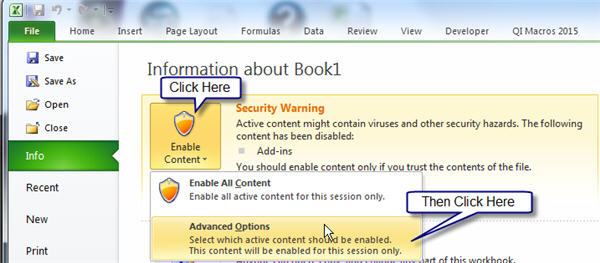
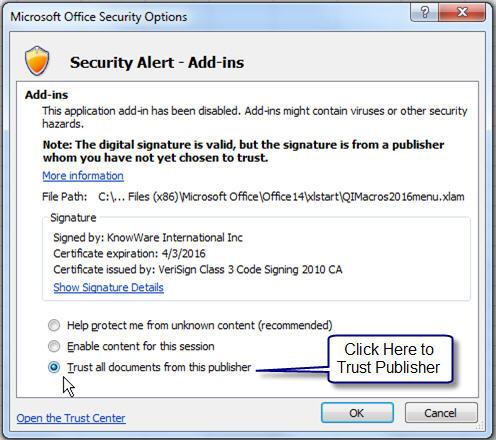
Once you have done so, completely quit out of Excel and reopen – do you still receive a security warning when you open Excel?
If so, e-mail support@qimacros.com or call: 1.888.468.1537
Your macro security settings may be too high. To fix, follow the instructions below:
- Open Excel and open a blank workbook.
- Select File > Options > Trust Center > Trust Center Settings:
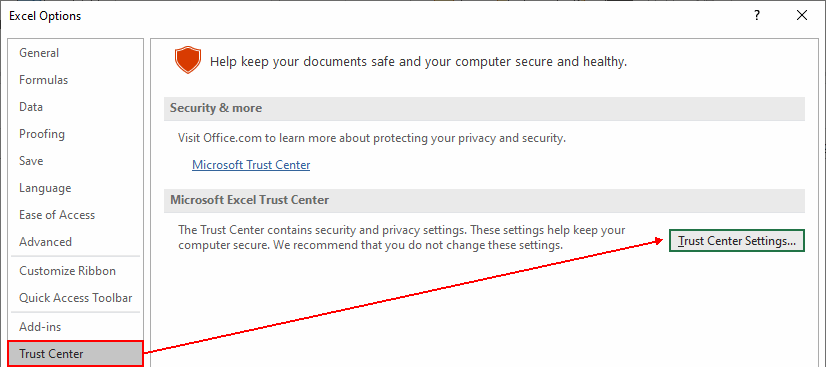
- Next, select “Macro Settings” – Excel default is “Disable all macros with notification.” To get the macros to run, given your security settings, you may need to set this to “Enable all macros”:

Once you have done so, completely quit out of Excel and reopen – is the macro still unresponsive?
If so, e-mail support@qimacros.com or call: 1.888.468.1537
Call or chat M-F 8 a.m. to 5 p.m. (MT) 888.468.1537
Trouble Reporting Form
If you can't find the answer to your problem on this page, please search our site:
If you cannot find an answer after searching our site, please complete the following trouble reporting form. We will respond within 24 hours, Monday through Friday, 8 a.m. to 5 p.m. MT. Thank you!

